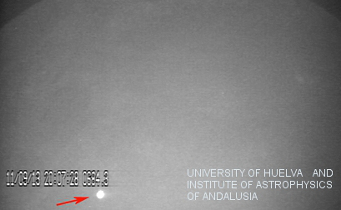Astronomers have witnessed the largest lunar impact to date. With an impact energy equivalent to 15 tons of TNT — approximately three times as great as the previous record-holder — the flash was visible even to the naked-eye.

J. Madiedo / MIDAS
In astronomy there’s an ongoing joke: if you can’t easily explain a specific phenomenon, then it was probably the result of a collision. The Moon likely formed when a Mars-sized object slammed into Earth billions of years ago, dinosaurs probably became extinct when an asteroid hit Earth at the end of the Mesozoic era, and chances are elliptical galaxies are created when two or more galaxies collide.
Another great example is easily seen when one simply peers up at the full Moon. Even with the naked eye, you can see a vast number of impact craters — marking collisions that span the majority of the Moon’s 4.5-billion-year history. Without an atmosphere, small rocks from space can effortlessly leave their marks on the Moon’s surface.
But rarely do we actually see these collisions take place. So scientists have set up networks of telescopes that detect them by looking for bright flashes on the Moon’s surface. One such automated system worked remarkably well on September 11th, 2013, when two telescopes in Seville, Spain, picked up a flash so intense it took eight seconds to fade.
As brilliant as the famous SN 1987A in the Large Magellanic Cloud, September's flare was undoubtedly the result of a rock crashing into the lunar surface. Astronomer José M. Madiedo (University of Huelva) saw this footage of the strike once the telescopes’ software had processed the impact:
Impacts take place at huge speeds, causing the meteorites to become vaporized at the impact site instantaneously. This produces a thermal glow that can easily be detected in any automated system.
Typically these flashes last a fraction of a second. But the much longer flash produced last September occurred when a meteorite with an impact energy equivalent to 15 tons of TNT — approximately three times as great as the previous record-holder — slammed into the unlit side of the Moon.
Madiedo and his collaborators believe the meteorite weighed 880 pounds (roughly half the mass of a small car) and crashed at a speed of 40,000 miles per hour. It likely punched a fresh crater roughly 150 to 200 feet wide into the ancient lava-filled basin known as Mare Nubium.
The event was recorded under a five-year-long automated project entitled the Moon Impacts Detection and Analysis System (MIDAS). It captures scores of much smaller lunar impacts every day as tiny meteorites weighing only a few grams hit the Moon roughly every 3 hours. By collecting statistics on these collisions, Madiedo hopes to learn about similar threats to the Earth.
However, even meteorites this large don’t pose a threat to Earth, as most would burn up in our upper atmosphere. The meteorite that triggered the mass extinction of the dinosaurs 65 million years ago, for instance, was thousands of times larger than this one.
Reference:
José M. Madiedo, José L. Ortiz, Nicolás Morales and Jesús Cabrera-Caño “A large lunar impact blast on 2013 September 11” Monthly Notices of the Royal Astronomical Society, in press.
 5
5
Comments
Anthony Barreiro
February 24, 2014 at 2:20 pm
In Madiedo et al.'s article referenced above they estimate that the size of the meteoroid was between 61 and 142 cm. A meteoroid of that size would probably completely burn up in Earth's atmosphere, or it might scatter some small meteorites for collectors to pick up. But this one made a crater estimated to be between 46 and 56 meters on the surface of the Moon. Hopefully the Lunar Reconnaissance Orbiter will take some pictures soon. As some people think about permanent human colonies on the Moon, I hope they're also factoring in the fact that the Moon doesn't have an atmosphere to slow down meteoroids before they hit the surface.
You must be logged in to post a comment.
Anthony Barreiro
February 25, 2014 at 11:46 am
Here's a five-minute video Jose Madiedo produced for public outreach with useful background about the Moon, meteors, and lunar impacts, footage of this impact, and a discussion of the risk or impacts on the Earth.
https://www.youtube.com/watch?v=perqv4qByaI
You must be logged in to post a comment.
Chris F.
February 26, 2014 at 8:01 am
Will the LRO be able to get some photos of the impact crater it left? Would be interesting to study this new crater and the effect it had on the surrounding area.
You must be logged in to post a comment.
Chris F.
February 27, 2014 at 7:18 pm
Forgot to add, will this cause more problems for the mirrors on the moon that are being covered with dust?
That was a pretty big impact that could have a fall out across on the lunar mirrors area that might be effected?
Just wondering?
You must be logged in to post a comment.
Stargeezer 15601
March 4, 2014 at 10:35 am
So the moon got smacked with a rock big enough to produce an 8 second flash in Mare Nubium? Can the amateur telescope see that resulting crater? Approximately what size is this crater and what are the selenographic latitude and longitude? I have excellent atlas photos of Mare Nubium to compare with a picture I could take tonight. Could I spot that crater? What would be the aperature of a telescope big enough to resolve this hit?
You must be logged in to post a comment.
You must be logged in to post a comment.